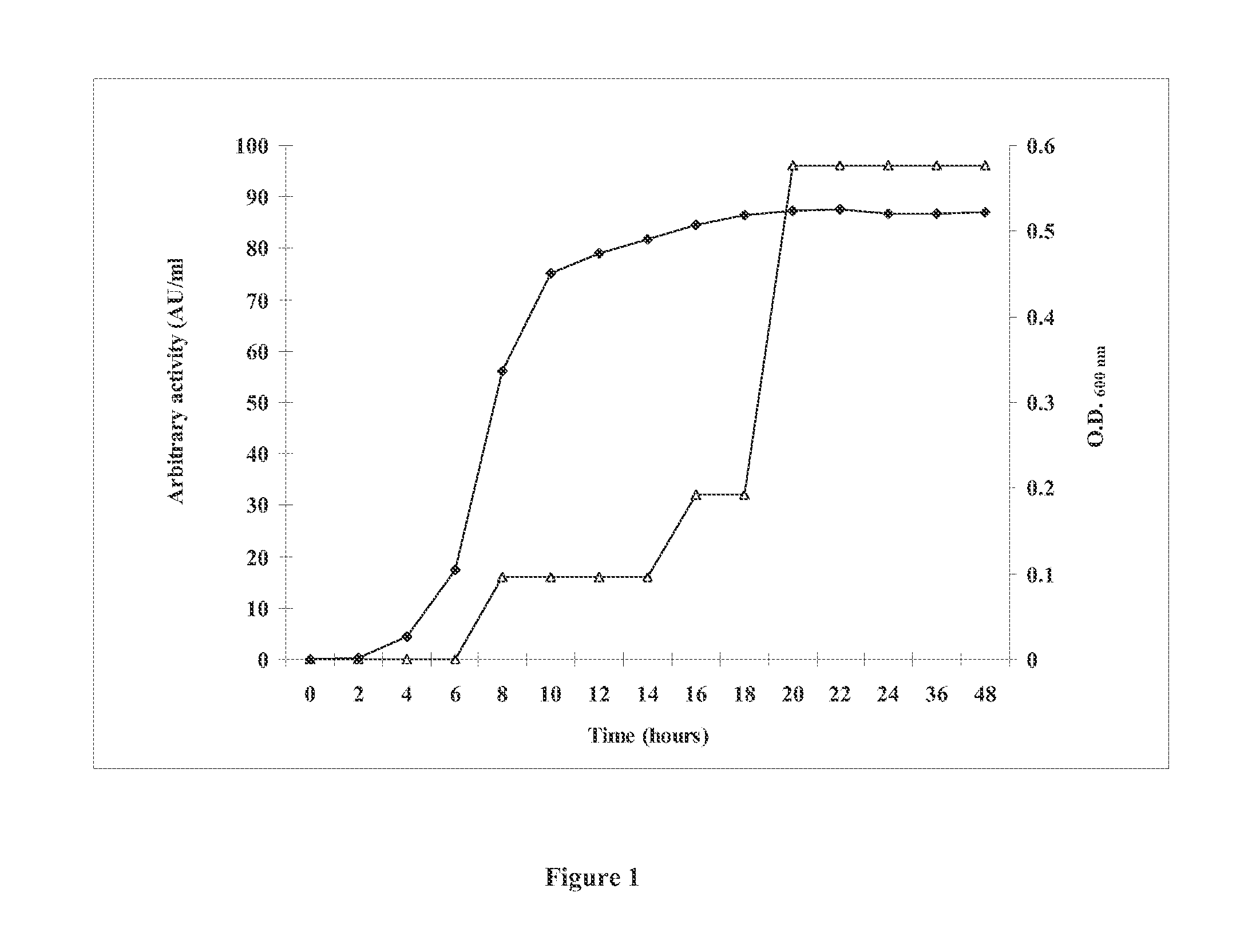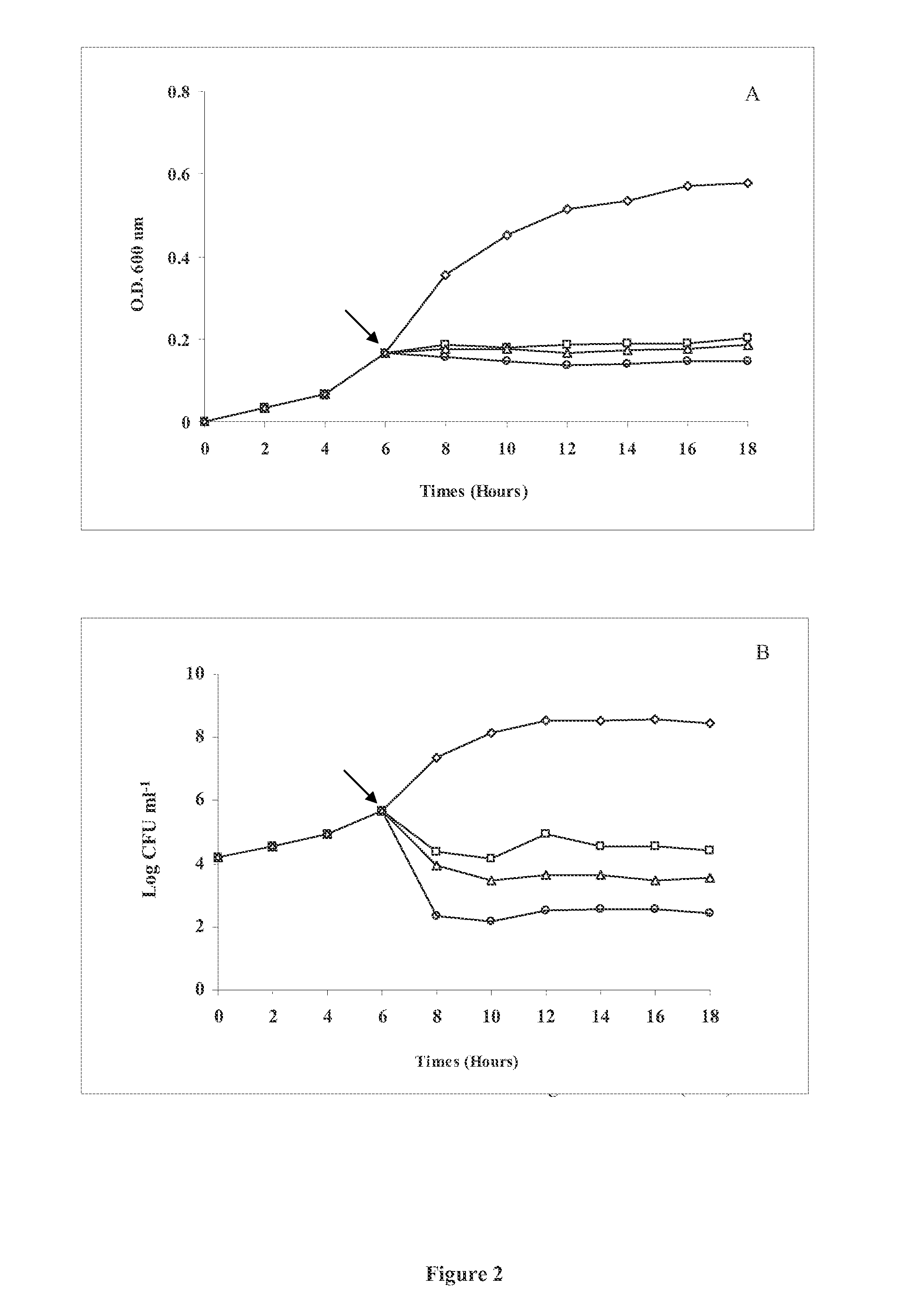Anti-microbial agent from paenibacillus sp. and methods and uses thereof
a technology of anti-microbial agents and paenibacillus, which is applied in the field of anti-microbial agents derived from paenibacillus, can solve the problems of reducing the effectiveness of colistin, affecting the survival of animals, so as to reduce the mortality or morbidity of animals
- Summary
- Abstract
- Description
- Claims
- Application Information
AI Technical Summary
Benefits of technology
Problems solved by technology
Method used
Image
Examples
example 1
Identification of Antimicrobial Agent Producing Strains Bacterial Strains and Growth Media
[0121]The bacterial indicator strains used are listed in Table 1. All were maintained at −80° C. in appropriate media containing 10% glycerol (w / v). P. polymyxa and all indicator strains except Butyrivibrio fibrisolvens and Fibrobacter succinogenes were propagated aerobically at 30° C. in their respective culture media as indicated in Table 1. The media used were: Tryptic soy broth (TSB) (Difco Laboratories, Sparks, Md., USA), de Man, Rogosa and Sharpe broth (MRS) (Rosell Institute, Montreal, PQ, Canada) (de Man et al. 1960) and Luria-Bertani (LB) broth. Liquid or solid (1.2% w / v agar) anaerobic L-10 medium containing glucose, maltose and soluble starch as carbon sources (each at 0.1% w / w) was used for the growth of B. fibrisolvens and F. succinogenes (Caldwell and Bryant 1966). Their growth was carried out at 39° C. in a CO2:H2 atmosphere (95:5 v / v). Before starting the experiments, all strain...
example 2
Production of the Antimicrobial Agent
[0128]One litre of LB medium was inoculated with 10 ml of a fresh, overnight culture of P. polymyxa JB05-01-1 and incubated at 30° C. with agitation at 200 rpm. The culture optical density at 600 nm was measured every two hours using a Multi-detection micro-plate reader (Bio-Teck instrument Inc., Winooski, Vt., USA), and 1 mL of culture was centrifuged (8,000 rpm, 10 min, 4° C.) to remove the cells. The supernatant was heated at 70° C. for 10 min to inactivate any protease activity, as described by Martin et al. (2003). The agar diffusion assay and micro-dilution method were used to test the heated supernatants for antimicrobial activity as described herein.
[0129]The determination of soluble protein was done using the Folin phenol reagent method as described by Lowry et al. (1951) with bovine serum albumin as standard. Polymyxin E, Polymyxin B and Nisin A were used as positive control for antimicrobial activity. Nisin A stock solutions were prepa...
example 3
Spectrum of Activity
[0131]The qualitative antimicrobial spectrum of P. polymyxa culture supernatant was determined using the agar well diffusion method (Wolf and Gibbons 1996). Briefly, a 25-ml volume of molten tryptic soy agar (0.75% agar w / v) was cooled to 47° C. and seeded with 1% (v / v) overnight TSB culture of an indicator strain. The seeded agar was then poured into a sterile Petri plate and allowed to solidify at room temperature. Wells (7 mm) were cut in the solidified agar using a sterile metal cork borer and filled with 80 μl of supernatant. The plates were left at 5° C. for 2 h to allow diffusion of the tested aliquot and then incubated aerobically for 18 h at 30° C. Absence or presence of inhibition zones as well as their diameters were recorded.
[0132]The antimicrobial activity was also determined by the micro-dilution method described by Daba et al. (1994). Activity was expressed in arbitrary units per milliliter (AU ml−1) using the formula (1000 / 125)×(1 / D), where D was ...
PUM
| Property | Measurement | Unit |
|---|---|---|
| Mass | aaaaa | aaaaa |
| Mass | aaaaa | aaaaa |
| Electrical conductance | aaaaa | aaaaa |
Abstract
Description
Claims
Application Information
 Login to View More
Login to View More - R&D
- Intellectual Property
- Life Sciences
- Materials
- Tech Scout
- Unparalleled Data Quality
- Higher Quality Content
- 60% Fewer Hallucinations
Browse by: Latest US Patents, China's latest patents, Technical Efficacy Thesaurus, Application Domain, Technology Topic, Popular Technical Reports.
© 2025 PatSnap. All rights reserved.Legal|Privacy policy|Modern Slavery Act Transparency Statement|Sitemap|About US| Contact US: help@patsnap.com



